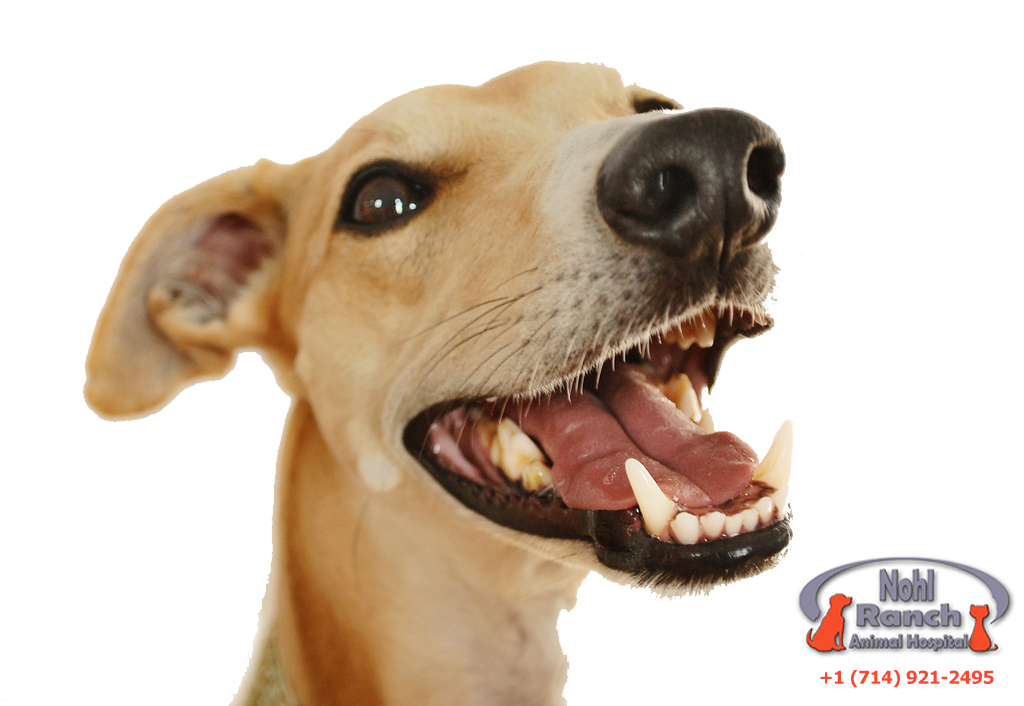February is National Dental Health Month for PetsThe month of February is National Pet Dental Health Month While this reminder holiday is celebrated annually, doctors from Nohl Ranch Animal Hospital are encouraging pet parents to talk to their family veterinarians about helping their pets practice good dental hygiene. According to the American Veterinary Dental Society (AVDS), after they reach age 3, 80% of dogs and 70% of cats will manifest some form of dental disease. This can be easily prevented with regular checkups and visits at Nohl Ranch Animal Hospital. Home monitoring is of great importance too. Checking the mouth of your pet at least once a week can be crucial for preventing dental disease.
Why IS PET DENTAL HEALTH IMPORTANT? Pet’s poor dental health can lead to secondary diseases. Studies have shown that dental diseases can lead to heart, lungs and liver problems. We believe that the source of feline dental problems is their modern diet. Their vicious teeth are specially designed to eat the prey whole, devouring bones, hair, and feathers that help keep their teeth clean. With eating kibble every day, tartar and plaque buildup is unavoidable, Over time this can develop into periodontal disease, which erodes at the gums and can result in bad breath, bleeding gums, and pain. How pets use their teeth? Your pet relies on his or her teeth to not only eat, meow or bark, and chew but also to function as hands. Pets will carry items, investigate new objects, and defend themselves with their teeth. These are the more reasons to make sure your pet’s teeth are in tip-top shape. While there are some dental diseases that are immediately present at the surface, such as abscesses, lacerations, or broken teeth, there are many underlying diseases that are caused by poor dental health. A disease that starts in the teeth and gums can eventually lead to kidney and heart disease or problems with the intestinal tract or joints.
What Is a Dental Cleaning? During a dental cleaning, plaque and tartar are removed from a pet’s teeth, and the health of the entire mouth (tongue, gums, lips, and teeth) is assessed. A thorough dental cleaning can be accomplished only while the pet is under general anesthesia. Anesthesia keeps your pet free of pain during the dental procedure and allows your veterinarian to fully inspect the teeth and remove tartar from under the gums. During anesthesia, a soft plastic tube is inserted into the trachea (the main airway in the throat) to support the patient’s breathing. Placement of the tracheal tube also prevents inhalation of bacteria that are aerosolized during the dental cleaning.
What are the symptoms of dental disease? |
| Bad breath
Loose teeth Gingivitis (inflammation of the gums) Chattering Excessive drooling Lack of appetite or reluctance to eat hard food Bleeding gums Periodontal disease is painful. Animals cannot speak, so it is up to us to take responsibility for their care. If you think your pet may have periodontal disease, schedule an appointment to have our vet perform an oral exam. He or she may inform you that you need to schedule a dental exam and cleaning.
A dental cleaning includes: · Removal of visible plaque and tartar from the teeth · Elimination of plaque and tartar from under the gum · Probing of dental sockets to assess dental disease · Polishing to smooth enamel scratches that may attract bacteria · Application of fluoride or a dental sealer · Removal of fractured or infected teeth · Dental charting so progression of dental disease can be monitored over time · Inspection of the lips, tongue, and entire mouth for growths, wounds, or other problems.
How can we help?
Call to schedule an appointment today!
25% off Dental and 10% off any Extractions, if needed! Offer valid only through the month of February 2019.
*Must present Coupon to redeem. Click Here |

